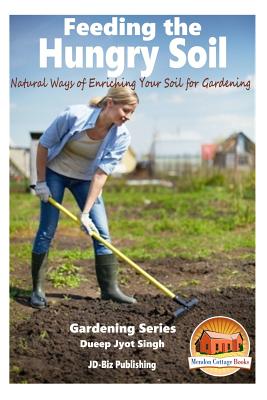
Feeding the Hungry Soil - Natural Ways of Enriching Your Soil for Gardening
Paperback
ISBN13: 9781519202673
Publisher: Createspace
Published: Nov 10 2015
Pages: 60
Weight: 0.27
Height: 0.16 Width: 6.00 Depth: 9.00
Language: English
Also in
General Gardening
The Self-Sufficiency Garden: Feed Your Family and Save Money: The #1 Sunday Times Bestseller
Richards, Huw
Cooper, Sam
Hardcover
Garden Wonderland: Create Life-Changing Outdoor Spaces for Beauty, Harvest, Meaning, and Joy
Bennett, Leslie
Chai, Julie
Hardcover
Paint by Sticker: Plants and Flowers: Create 12 Stunning Images One Sticker at a Time!
Workman Publishing
Paperback
Growing Bulbs in the Natural Garden: Innovative Techniques for Combining Bulbs and Perennials in Every Season
Van Der Kloet, Jacqueline
Hardcover
The Backyard Homestead Guide to Growing Organic Food: A Crop-By-Crop Reference for 62 Vegetables, Fruits, Nuts, and Herbs
Cobb, Tanya Denckla
Paperback
Carrots Love Tomatoes: Secrets of Companion Planting for Successful Gardening
Riotte, Louise
Paperback
The Cut Flower Handbook: Select, Plant, Grow, and Harvest Gorgeous Blooms
Ziegler, Lisa Mason
Hardcover
Grace Rose Farm: Garden Roses: The Complete Guide to Growing & Arranging Spectacular Blooms
Poulson, Gracielinda
Hardcover
Plant Partners: Science-Based Companion Planting Strategies for the Vegetable Garden
Walliser, Jessica
Paperback
Black and Decker the Complete Guide to DIY Greenhouses 3rd Edition: Build Your Own Greenhouses, Hoophouses, Cold Frames & Greenhouse Accessories
Editors of Cool Springs Press
Peterson, Chris
Paperback
Vegetable Gardening Made Easy: Simple Tips & Tricks to Grow Your Best Garden Ever
Gala, Resh
Hardcover
Wild Witchcraft: Folk Herbalism, Garden Magic, and Foraging for Spells, Rituals, and Remedies
Beyer, Rebecca
Hardcover
Worms Eat My Garbage, 35th Anniversary Edition: How to Set Up and Maintain a Worm Composting System: Compost Food Waste, Produce Fertilizer for Housep
Olszewski, Joanne
Appelhof, Mary
Paperback
All New Square Foot Gardening, 3rd Edition, Fully Updated: More Projects - New Solutions - Grow Vegetables Anywhere
Bartholomew, Mel
Square Foot Gardening Foundation
Paperback
A Gardener's Guide: Native Planting for Ontario's Pollinator and Predator Insects
Dhinsa, Bipin
Paperback
The Ruth Stout No-Work Garden Book: Secrets of the Famous Year Round Mulch Method
Clemence, Richard
Stout, Ruth
Paperback
The Green Witch's Garden: Your Complete Guide to Creating and Cultivating a Magical Garden Space
Murphy-Hiscock, Arin
Hardcover
Ultimate Guide to Walks, Patios & Walls, Updated 2nd Edition: Plan - Design - Build
Editors of Creative Homeowner
Paperback
The Food Forward Garden: A Complete Guide to Designing and Growing Edible Landscapes
Douglas, Christian
Hardcover
How Not to Kill Your Houseplant New Edition: Survival Tips for the Horticulturally Challenged
Peerless, Veronica
Hardcover
Plants for the Winter Garden: Perennials, Grasses, Shrubs, and Trees to Add Interest in the Cold and Snow
Leach, Warren
Hardcover
Wicked Plants: The Weed That Killed Lincoln's Mother & Other Botanical Atrocities
Stewart, Amy
Hardcover
Botany for Gardeners, Fourth Edition: An Introduction to the Science of Plants
Capon, Brian
Paperback
Raised Bed Gardening A Simple-to-Understand Guide to Raised Bed Gardening For Beginners
Hudson, Kelly T.
Paperback
The Money-Saving Gardener: Create Your Dream Garden at a Fraction of the Cost: The Sunday Times Bestseller
Lautenbach, Anya
Hardcover
Seed to Seed: Seed Saving and Growing Techniques for Vegetable Gardeners, 2nd Edition
Ashworth, Suzanne
Paperback
The Container Garden Recipe Book: 57 Designs for Pots, Window Boxes, Hanging Baskets, and More
Williams, Lana
Hardcover
Bird-Friendly Gardening: Guidance and Projects for Supporting Birds in Your Landscape
McGuinness, Jen
Paperback
Complete Starter Guide to Bonsai: Growing from Seed or Seedling--Wiring, Pruning, Care, and Display
Squire, David
Paperback
How to have a green thumb without an aching back: A new method of mulch gardening
Stout, Ruth
Paperback
The Mycocultural Revolution: Transforming Our World with Mushrooms, Lichens, and Other Fungi
McCoy, Peter
Hardcover
The Northeast Native Plant Primer: 235 Plants for an Earth-Friendly Garden
Lorimer, Uli
Native Plant Trust
Paperback
The Pacific Northwest Native Plant Primer: 225 Plants for an Earth-Friendly Garden
Currin, Kristin
Merritt, Andrew
Paperback
Herbal Medicine for Beginners: Your Guide to Healing Common Ailments with 35 Medicinal Herbs
Midura, Ryn
Swift, Katja
Paperback
A Northern Gardener's Guide to Native Plants and Pollinators
Johnson, Lorraine
Colla, Sheila
Paperback
Kitchen Gardening for Beginners: Regrow Your Leftover Greens, Stalks, Seeds, and More
Elzer-Peters, Katie
Paperback
Grow a Little Fruit Tree: Simple Pruning Techniques for Small-Space, Easy-Harvest Fruit Trees
Ralph, Ann
Paperback
Spiders of the United States & Canada: Easily Identify 158 Common Species
Echeverri, Sebastian Alejandro
Paperback
The Timber Press Guide to Vegetable Gardening in the Pacific Northwest
Forkner, Lorene Edwards
Paperback
Food Forest Revolution: how food forests everywhere could change everything
Reelitz, Jennifer Taber
Paperback
Gardening with Native Plants of the Pacific Northwest
Kruckeberg, Arthur R.
Chalker-Scott, Linda
Paperback
Practical Permaculture: For Home Landscapes, Your Community, and the Whole Earth
Bloom, Jessi
Boehnlein, Dave
Paperback
Raised-Bed Gardening for Beginners: Everything You Need to Know to Start and Sustain a Thriving Garden
Wylie, Tammy
Paperback
Planting in a Post-Wild World: Designing Plant Communities for Resilient Landscapes
Rainer, Thomas
West, Claudia
Hardcover
Kitchen Garden Revival: A Modern Guide to Creating a Stylish, Small-Scale, Low-Maintenance, Edible Garden
Burke, Nicole Johnsey
Hardcover
Four-Season Harvest: Organic Vegetables from Your Home Garden All Year Long, 2nd Edition
Coleman, Eliot
Paperback
Gardening for Abundance: Your Guide to Cultivating a Bountiful Veggie Garden and a Happier Life
Brigantti, Brian
Paperback
Basilius Besler. Florilegium. the Book of Plants
Dressendörfer, Werner
Littger, Klaus Walter
Hardcover
Week-By-Week Vegetable Gardener's Handbook: Perfectly Timed Gardening for Your Most Bountiful Harvest Ever
Kujawski, Ron
Kujawski, Jennifer
Paperback
Fern Finder: A Guide to Native Ferns of Central and Northeastern United States and Eastern Canada
Hallowell, Barbara
Paperback
Weeds of the Pacific Northwest: 368 Unwanted Plants and How to Control Them
Gray, Sami
Turner, Mark
Paperback
Cómo No Matar Tus Plantas (How Not to Kill Your Houseplant): Nueva Edición
Peerless, Veronica
Hardcover
Grow All You Can Eat in 3 Square Feet: Inventive Ideas for Growing Food in a Small Space
DK
Paperback
Companion Planting for Beginners: Pair Your Plants for a Bountiful, Chemical-Free Vegetable Garden
Lowell, Brian
Paperback
Psilocybin: Magic Mushroom Grower's Guide: A Handbook for Psilocybin Enthusiasts
Oeric, O. N.
Oss, O. T.
Paperback
¡Verdura! - Jardinería Para Tu Bienestar / ¡Verdura! - Living a Garden Life (Spanish Edition): 30 Proyectos Para Nutrir Tu Pasión Por Las Plantas Y Se
Curbelo-Santiago, Perla Sofía
Paperback
Kew: The Witch's Garden: Plants in Folklore, Magic and Traditional Medicine
Lawrence, Sandra
Hardcover
Houseplants for Beginners: A Simple Guide for New Plant Parents for Making Houseplants Thrive
Steinkopf, Lisa Eldred
Paperback
Growing an Edible Landscape: How to Transform Your Outdoor Space Into a Food Garden
D'Amore, Chiara
Pilarchik, Gary
Paperback
The Compost Coach: Make Compost, Build Soil and Grow a Regenerative Garden - Wherever You Live!
Flood, Kate
Paperback
The Green Dumb Guide to Houseplants: 45 Unfussy Plants That Are Easy to Grow and Hard to Kill
Theisen-Jones, Holly
Hardcover
Botanical Art Techniques: A Comprehensive Guide to Watercolor, Graphite, Colored Pencil, Vellum, Pen and Ink, Egg Tempera, Oils, Printmaking, an
Woodin, Carol
Jess, Robin A.
American Society of Botanical Artists
Hardcover
Practical Botany for Gardeners: Over 3,000 Botanical Terms Explained and Explored
Hodge, Geoff
Hardcover
The Celestial Garden: Growing Herbs, Vegetables, and Flowers in Sync with the Moon and Zodiac
Stevens, Jane Hawley
Paperback
The Lean Micro Farm: How to Get Small, Embrace Local, Live Better, and Work Less
Hartman, Ben
Paperback
The Complete Gardener: A Practical, Imaginative Guide to Every Aspect of Gardening
Don, Monty
Hardcover
100 Plants to Feed the Birds: Turn Your Home Garden Into a Healthy Bird Habitat
Erickson, Laura
Paperback
The Living Landscape: Designing for Beauty and Biodiversity in the Home Garden
Tallamy, Douglas W.
Darke, Rick
Hardcover
The Plant Propagator's Bible: A Step-By-Step Guide to Propagating Every Plant in Your Garden
Smith, Miranda
Paperback
The Winter Harvest Handbook: Year Round Vegetable Production Using Deep-Organic Techniques and Unheated Greenhouses
Coleman, Eliot
Paperback
Designing Gardens with Flora of the American East, Revised and Expanded
Summers, Carolyn
Brittenham, Kate
Paperback
Gardening Through the Year: Month-By-Month Planning, Instructions, and Inspiration
Spence, Ian
Hardcover
The Climate Change-Resilient Vegetable Garden: How to Grow Food in a Changing Climate
Stoddart, Kim
Paperback
Container and Small-Space Gardening for the South: How to Grow Flowers and Food No Matter Where You Live
Ellis, Barbara W.
Paperback
Teaming with Microbes: The Organic Gardener's Guide to the Soil Food Web
Lowenfels, Jeff
Lewis, Wayne
Hardcover
Real Gardens Grow Natives: Design, Plant, and Enjoy a Healthy Northwest Garden
Stark, Eileen
Paperback
The New Plant Parent: Develop Your Green Thumb and Care for Your House-Plant Family
Cheng, Darryl
Paperback
Caterpillars of North America: Easily Identify 90 Common Butterflies and Moths
Daniels, Jaret C.
Paperback
The Seven-Step Homestead: A Guide for Creating the Backyard Microfarm of Your Dreams
Webb, Leah M.
Paperback
Pacific Northwest Month-By-Month Gardening: What to Do Each Month to Have a Beautiful Garden All Year
Pfeiffer, Christina
Paperback
Edible Wild Plants for Beginners: The Essential Edible Plants and Recipes to Get Started
Althea Press
Paperback
Shrouded in Light: Naturalistic Planting Inspired by Wild Shrublands
Guidi, Michael
Williams, Kevin Philip
Hardcover
Hidroponía: Una guía para principiantes para construir su propio jardín hidropónico
Gordon, Tom
Paperback
The Naturally Beautiful Garden: Designs That Engage with Wildlife and Nature
Bradley-Hole, Kathryn
Hardcover
The Regenerative Garden: 80 Practical Projects for Creating a Self-Sustaining Garden Ecosystem
Rose, Stephanie
Paperback


 Sign-In
Sign-In Cart
Cart